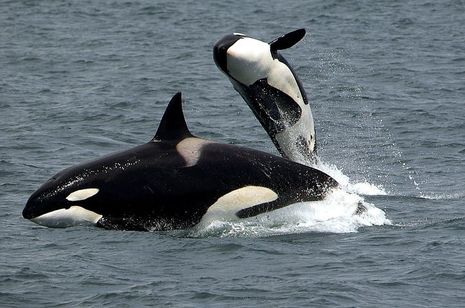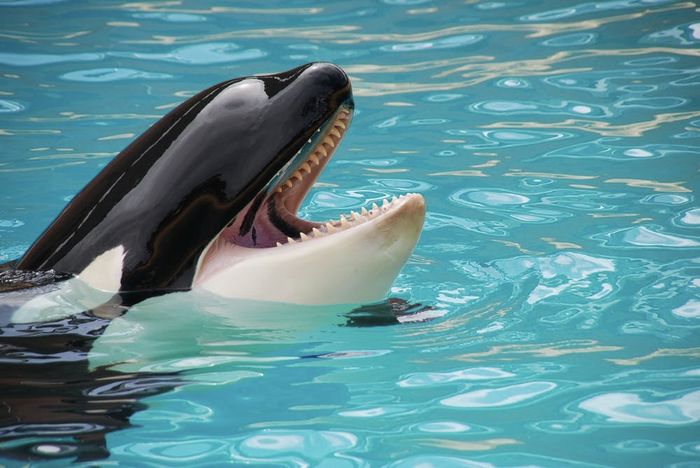Beneath the surface: A fresh perspective on marine captivity
Given the strain imposed on us by the 10 week lockdown so far, Niamh Casstles asks why we are so willing to impose drastic restrictions on such globetrotting marine animals as the orca – especially given the fatal consequences.

Our understanding of the word has changed drastically since the emergence of COVID-19.
Keeping us from seeing our families, splitting up groups of friends and taking away our freedom – it now represents ten weeks of the most significant restrictions on British life in living memory. Feelings of loneliness have almost doubled and mental health charities have raised concerns of worrying long-term implications. We understand the negative effects of confinement and are aware of its role as an incubator of psychoses, seeding illness in otherwise healthy individuals.
So why have we allowed other species to suffer such intense degrees of isolation?
Research proves that, like us, animals suffer when held in captivity – especially if they are confined in a manner that renders them unable to perform important species-specific behaviours. Possessing the second-biggest brains among all ocean mammals, a vastly enlarged limbic system controlling their behavioural and emotional responses and incredible intelligence, orcas are among the worst effected by human-imposed ‘lockdowns’ – a fact which is made only more tragic by the circumstances of their imprisonment since 1961.
SeaWorld have made several claims regarding the manner in which their orcas are kept.
They claim that their living conditions are not harmful. They state that their orcas live longer when held in captivity than in the wild due to veterinary care. They tell visitors that the orcas are housed in their familial pods, dismissing the dorsal-fin collapse experienced by 100% of males in captivity as a normal part of ageing experienced by 25% of all orcas.
These are SeaWorld’s claims.
The facts say otherwise.
The statements that SeaWorld have made regarding their treatment of these magnificent animals are false: the concrete tanks that they are kept in are 34 feet at their deepest, despite orcas frequently diving up to 1000 feet in the wild; and in order to mimic their natural movements, orcas must swim over 3000 lengths of their pool daily. Orcas have complex needs that cannot be met in captivity and research shows that they live just as long (if not longer) than humans, in the wild. Similarly, dorsal collapse is not a problem outside of captivity, occurring in fewer than 1% of wild orcas.
“Brancheau’s death was the 150th recorded violent incident between a human and a captive orca since 1967.”
Despite wild orcas forming life-long bonds within their pods, former SeaWorld employees confirmed that the groupings of orcas within the park are no more than an artificial assemblage decided by management. In the wild a calf would never leave its mother’s side, even into adulthood – yet they are frequently taken from their mothers to be sold for profit. This traumatizes the mothers and their still-dependent calves. One of the most callous examples of this unethical practice can be seen in SeaWorld’s separation of calf Takara from her mother Kasatka, who wailed, screamed and cried out long after her child was snatched away from her. Analysis of her vocalisations showed them to be long-range: a heart-wrenching last-ditch attempt to contact her calf – something no orca had tried before.
These orcas have been expressing their frustration at the oppressive conditions in which they are confined for decades. Orca pods are tightknit matrilineal groups, led by older females that model behaviours to younger animals, a dynamic which is impossible to achieve in the confines of captivity. While superficially similar, orcas from separate pods couldn’t be more socially distinct, using different behavioural cues and languages to communicate. Confusion caused by forced interactions often results in hostile and unnaturally aggressive behaviour between orcas. Neuroscientist Lori Marino explains that forcing orcas that have grown up in different regions into close proximity results in hyper-aggression and violence. This negligence led Kandu, a 14-year-old female to a slow and painful death; fracturing her mandible, puncturing an artery in her head, and ultimately bleeding out as a result of an attempted ramming on 25-year old female Corky.

The documentary Blackfish follows the life of male orca ‘Tilikum’. Although there is no record of an orca doing any harm to any human in the wild, Tilikum was involved in the deaths of three people; Keltie Byrne (a trainer at Sealand of the Pacific), Daniel Dukes (a man trespassing in SeaWorld Orlando), and SeaWorld Orlando trainer Dawn Brancheau.
“Orcas in the wild are known for being amazingly friendly, understanding, and intuitively wanting to be your companion.”
Given the frequency and clarity of the warning signs that preceded them, these deaths are further indicators of SeaWorld’s egregious conduct; Brancheau’s death was the 150th recorded violent incident between a human and a captive orca since 1967.
Tilikum made his first kill in 1991, while performing at Sealand of the Pacific. Here, Tilikum would be trained alongside an established orca, with both animals receiving punishment if he made a mistake. At night, the whales were locked together in a small floating steel box, where the females would take out their pent-up frustrations on Tilikum, repeatedly scratching him with their teeth, gouging his flesh, and causing him to bleed. Nadine Kallen was witness to the attack on Keltie Byrne, a 20-year-old championship swimmer and part-time Sealand employee. For ten minutes she watched as Keltie was submerged for varying intervals, screaming for her life. Nadine insisted that Keltie was pulled under by Tilikum. “It was very easy to tell”, she explained: he was the whale with the “flopped over fin”.
Sealand closed after the incident, as the attack on Keltie was deemed so highly stimulating that it was likely to be repeated. Nevertheless, Tilikum was bought by SeaWorld, arriving at the park in 1992. They needed a male for breeding.
Tilikum struck again in July of 1999 – this time killing Daniel Dukes, a man who voluntarily entered his tank at night while trespassing at SeaWorld. Dukes’ naked and dismembered body was found draped over Tilikum’s back in the morning. Tilikum had bitten off his genitals and was parading him around the tank. It’s hard to believe Dukes wasn’t found until the morning: why didn’t one of the four night-watch trainers required to check on Tilikum twice an hour see the body in the water or hear Dukes floundering and splashing as he drowned? Dukes’ death will be forever remembered as SeaWorld’s first major incident.
“They all have a bad life, they’re all emotionally destroyed and psychologically traumatised, so they are all ticking time bombs.”
Other orcas began lashing out in similarly anguish-driven attacks. In 2002, Tamarie (a SeaWorld trainer) was attacked by Orkid and Splash, luckily escaping with just a broken arm – Orkid has shown clear escalation and despite not having progressed to killing a person, she has been involved in 17 attacks on humans. In 2006, Kasatka attacked former trainer Ken Peters as a shocked audience watched on. She dragged Peters under by his left foot for more than thirty seconds, releasing him briefly before plunging him down again for more than a minute. Peters was able to scramble to safety in spite of his crushed feet, but if he wasn’t such an experienced diver, things could’ve ended very differently. On Christmas Eve of 2009, Alexis Martínez lost his life. He was a trainer at Loro Parque, a zoo in Tenerife, before the attack in which he was pulled underwater and rammed in the chest by Keto, one of four orcas the park had been loaned by SeaWorld.
He didn’t survive.
The story of Dawn Brancheau, Tilikum’s final fatality, is perhaps the most harrowing – occurring two months after the death of Martínez, to the day. Dawn was a senior trainer, respected by her peers and a stickler for following safety procedures. She was midway through a bonding session with Tilikum when he grabbed her by the arm and barrel-rolled, dragging her into the water. He ‘slammed into’ Dawn repeatedly, letting her go for brief periods before grabbing her again and shaking her violently, as her colleagues rushed to help. Even after they managed to raise him out of the water, he refused to give her up. Tilikum had scalped Dawn, and as staff attempted to free her, prising open his jaws, part of her arm came off in his mouth.
Sadly, her heart had stopped.
Tilikum had killed her.
The deaths of Keltie Byrne and Dawn Brancheau are almost 20 years apart, and nothing has been learned. With orcas able to pass on behaviours that can persist for generations it’s worrying that 54% of the remaining whales at SeaWorld share genes with Tilikum.
59 orcas remain in captivity, in parks and aquariums throughout the world and ‘they all have a bad life, they’re all emotionally destroyed and psychologically traumatised, so they are all ticking time bombs.’.
With this in mind, it may be hard to believe that orcas in the wild are known for being amazingly friendly, understanding, and intuitively wanting to be your companion. To evoke aggression from such majestic and peaceful animals is utterly devastating.
Visiting sea parks, visiting zoos, riding dolphins – all of these allow for the torment of these animals to continue under the guise of entertainment.
The COVID-19 lockdown has shown us all the pain isolation can bring.
May it also teach us compassion towards those who have suffered it far longer.
 News / CUP announces funding scheme for under-represented academics19 December 2025
News / CUP announces funding scheme for under-represented academics19 December 2025 News / Cambridge welcomes UK rejoining the Erasmus scheme20 December 2025
News / Cambridge welcomes UK rejoining the Erasmus scheme20 December 2025 News / SU reluctantly registers controversial women’s soc18 December 2025
News / SU reluctantly registers controversial women’s soc18 December 2025 Film & TV / Timothée Chalamet and the era-fication of film marketing21 December 2025
Film & TV / Timothée Chalamet and the era-fication of film marketing21 December 2025 News / News in Brief: humanoid chatbots, holiday specials, and harmonious scholarships21 December 2025
News / News in Brief: humanoid chatbots, holiday specials, and harmonious scholarships21 December 2025









